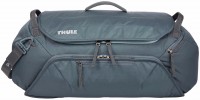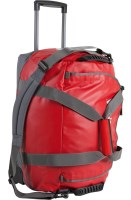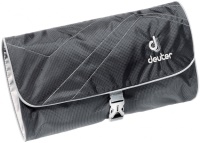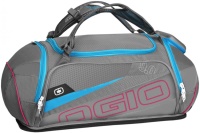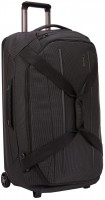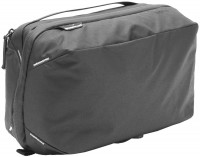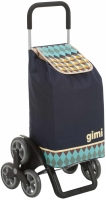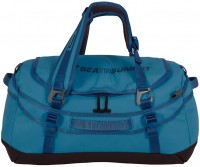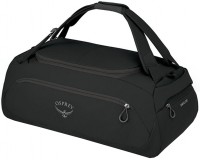Travel Bags Osprey
All Travel Bags Advanced filters → |
You might be interested in
Travel Bags: specifications, types
Main function
The general purpose of the bag depends primarily on the type.
— Travel bag. Bags designed primarily for travel. At the same time, their design can be very diverse - from classic leather goods, in a business or “glamorous” style, to fabric bags that look very similar to sports bags. Actually, sports bags can also be classified as travel models. They differ from classic road ones only in their interior design, designed to make it easy to carry sportswear and related equipment.
— Tactical. Multifunctional bags, originally designed for participation in tactical or combat operations. However, such bags are often taken on hikes, tourist excursions, hunting and fishing. Tactical bags are made from strong, wear-resistant and durable materials. They usually provide many internal compartments and pockets for storing various items; they also often offer the possibility of significantly increasing the volume of carried items due to the presence of fastenings using special systems. All compartments and pockets in the tactical bag are easy to access. In addition, models for this purpose often use military-style camouflage - “woodland”, “desert”, “flecktarn”, “pixel”, etc.
- Portfolio. Specialized bags for transporting clothes, incl. business, and in some models - also shoes. They have a design designed to ensure that the clothes inside do not wrinkle; Fo...r compactness, they are often folded in half. The capacity of briefcases can be different - from one suit to a supply of spare clothes for several days.
— Beauty case. Small handbags or suitcases designed for storing cosmetic, toiletry and hygiene items and usually aimed at a female audience. Thus, in terms of purpose, beauty cases are similar to cosmetic bags, but they can hold significantly more items (although the specific capacity, of course, may vary) and can be made of solid materials. In addition, such products have various equipment for ease of carrying - handles or even shoulder straps. With all this, the beauty case is quite suitable for the role of home storage of cosmetics.
- Cart. A distinctive feature of trolleys is the presence of a special frame, usually L-shaped, onto which the fabric bag is actually attached. At the top of the frame there is a handle for transportation; at the bottom there are two wheels and a support (supports), thanks to which the bag can stand vertically in a stationary position. You need to roll such a structure in an inclined position so that the supports rise above the ground - similar to a regular two-wheeled suitcase. However, trolley bags have larger wheels than most suitcases, making them more “passable” and better suited for long-term transportation “under their own power,” including on rather uneven surfaces. The disadvantage of such products is some bulkiness and increased weight.
- Road beautician. Small handbags designed for transporting cosmetic and hygiene items: toothbrushes, shampoos, deodorants/perfume, makeup, manicure supplies, etc. Note that although cosmetic bags are usually called mainly women's handbags, products for men are also produced in this category ; men's “beauty bags” are often called toiletries.
- Suitcase bag. Products that combine the features of travel bags and suitcases. This product usually looks like a bag, the bottom of which has a folding handle and a pair of wheels. Thanks to this, if you wish, you can put the bag vertically on its end, unfold the handle and roll it on wheels, like a suitcase. At the same time, thanks to soft materials, such bags take up less space than traditional suitcases and are more convenient to store when not in use.
Note that the division into types is quite arbitrary: many models can be used for “non-native” purposes, and belonging to one or another type may depend on how the manufacturer positions this model. For example, many road models are indistinguishable from sports models in appearance, and vice versa.
— Travel bag. Bags designed primarily for travel. At the same time, their design can be very diverse - from classic leather goods, in a business or “glamorous” style, to fabric bags that look very similar to sports bags. Actually, sports bags can also be classified as travel models. They differ from classic road ones only in their interior design, designed to make it easy to carry sportswear and related equipment.
— Tactical. Multifunctional bags, originally designed for participation in tactical or combat operations. However, such bags are often taken on hikes, tourist excursions, hunting and fishing. Tactical bags are made from strong, wear-resistant and durable materials. They usually provide many internal compartments and pockets for storing various items; they also often offer the possibility of significantly increasing the volume of carried items due to the presence of fastenings using special systems. All compartments and pockets in the tactical bag are easy to access. In addition, models for this purpose often use military-style camouflage - “woodland”, “desert”, “flecktarn”, “pixel”, etc.
- Portfolio. Specialized bags for transporting clothes, incl. business, and in some models - also shoes. They have a design designed to ensure that the clothes inside do not wrinkle; Fo...r compactness, they are often folded in half. The capacity of briefcases can be different - from one suit to a supply of spare clothes for several days.
— Beauty case. Small handbags or suitcases designed for storing cosmetic, toiletry and hygiene items and usually aimed at a female audience. Thus, in terms of purpose, beauty cases are similar to cosmetic bags, but they can hold significantly more items (although the specific capacity, of course, may vary) and can be made of solid materials. In addition, such products have various equipment for ease of carrying - handles or even shoulder straps. With all this, the beauty case is quite suitable for the role of home storage of cosmetics.
- Cart. A distinctive feature of trolleys is the presence of a special frame, usually L-shaped, onto which the fabric bag is actually attached. At the top of the frame there is a handle for transportation; at the bottom there are two wheels and a support (supports), thanks to which the bag can stand vertically in a stationary position. You need to roll such a structure in an inclined position so that the supports rise above the ground - similar to a regular two-wheeled suitcase. However, trolley bags have larger wheels than most suitcases, making them more “passable” and better suited for long-term transportation “under their own power,” including on rather uneven surfaces. The disadvantage of such products is some bulkiness and increased weight.
- Road beautician. Small handbags designed for transporting cosmetic and hygiene items: toothbrushes, shampoos, deodorants/perfume, makeup, manicure supplies, etc. Note that although cosmetic bags are usually called mainly women's handbags, products for men are also produced in this category ; men's “beauty bags” are often called toiletries.
- Suitcase bag. Products that combine the features of travel bags and suitcases. This product usually looks like a bag, the bottom of which has a folding handle and a pair of wheels. Thanks to this, if you wish, you can put the bag vertically on its end, unfold the handle and roll it on wheels, like a suitcase. At the same time, thanks to soft materials, such bags take up less space than traditional suitcases and are more convenient to store when not in use.
Note that the division into types is quite arbitrary: many models can be used for “non-native” purposes, and belonging to one or another type may depend on how the manufacturer positions this model. For example, many road models are indistinguishable from sports models in appearance, and vice versa.
trunk
Roomy bags are mostly cylindrical in shape with a large volume of internal space in which you can pack a huge number of things. Initially, trunks were used to transport the belongings of military personnel heading to another duty station or to long-term exercises. In common use, they are valued by avid travelers and tourists. The trunks are made from waterproof and durable materials; they also often have a semi-rigid design that helps protect the contents from damage and maintain the shape of the bag while transporting things.
Capacity
The total volume of the bag, usually, includes all regular pockets (including external ones). A large volume allows you to put a lot of things inside, but it significantly affects the dimensions, weight and price of the product itself. Therefore, when choosing, you need to strike a balance between capacity and convenience.
It is believed that a volume of 25 – 35 liters will be quite enough for the things one person needs for a trip lasting 3 – 4 days. More detailed recommendations can be found in special sources.
At the same time, we note that even with numerous things, a large bag is not always the best option. In some cases (for example, if several people are traveling), it is more convenient to buy several products of a relatively small volume and divide the luggage between travelers.
Now on the market there are such volumes of bags: small - up to 50 liters, medium - from 51 to 75 liters, large - from 76 to 100 liters and huge, whose volumes exceed 100 liters. At the same time, you should not forget that there are also travel bags for hand luggage, as well as an even smaller version of hand luggage for low-cost airlines.
It is believed that a volume of 25 – 35 liters will be quite enough for the things one person needs for a trip lasting 3 – 4 days. More detailed recommendations can be found in special sources.
At the same time, we note that even with numerous things, a large bag is not always the best option. In some cases (for example, if several people are traveling), it is more convenient to buy several products of a relatively small volume and divide the luggage between travelers.
Now on the market there are such volumes of bags: small - up to 50 liters, medium - from 51 to 75 liters, large - from 76 to 100 liters and huge, whose volumes exceed 100 liters. At the same time, you should not forget that there are also travel bags for hand luggage, as well as an even smaller version of hand luggage for low-cost airlines.
Volume change
The ability to increase / decrease the volume of the bag. It is mainly provided by unzipping the zipper around the perimeter. Thanks to the function of changing the volume, the capacity can be increased, and if not needed, reduced.
Material
The main material used in the construction of the bag.
— Polyester. Synthetic fibre based on polyester is characterized by good strength, resistance to moisture, ultraviolet radiation and temperature extremes, and at the same time it is relatively inexpensive. However the specific degree of strength and durability depends on the grade of polyester: the more expensive the bag, the more reliable the material, usually.
— Nylon. Another type of synthetic fibre, similar in basic properties to polyester. The term "nylon" can mean different types of polymers and, accordingly, the quality of this material can also be different — from a relatively short-lived fabric that is not intended for difficult conditions, to high-end solutions like Cordura. Usually the properties of nylon are directly related to the price category of the bag.
— Polyvinyl chloride. Polymeric material, usually used not in the form of fibers (like nylon and polyester), but in the form of continuous sheets. Due to this, PVC has good moisture resistance, and is inexpensive. Strength is average, among the shortcomings it is worth noting the poor suitability for low temperatures (-10 °C and below).
— Tarpaulin. A material that combines a polypropylene fibre base and a polyethylene film coating. This combination provides good strength combined wi...th water and UV resistance. At the same time, tarpaulin has a shiny surface and is slippery to the touch, which may not appeal to lovers of classic fabrics. Most products made from this material are sports or similar road products (see "Type").
— Caprovinil. Synthetic fibre, the thread of which is a nylon (kapron) base with a PVC coating applied on top — for durability and water resistance. For a number of reasons (in particular, due to the fact that the coating tends to peel off), caprovinil is considered a low-cost-level material and is used mainly in inexpensive bags.
— Jacquard. Jacquard is not called a material, but a special type of weaving of fibers; the fibers themselves can be either natural or synthetic. Jacquard weave provides strength, reliability, low tendency to stretch and resistance to temperature extremes; other characteristics and the overall quality of such fabric, usually, are determined by the price category of the bag.
— Skin. Genuine leather has a rich and representative appearance, however, it is not cheap. Therefore, the bulk of the bags made of this material belongs to the premium class. Of the practical advantages of leather, moisture resistance, reliability and durability can be noted. Its main disadvantage, in addition to the price, is the need for specific care. In general, it is not difficult, but ignoring this care leads to rapid aging and loss of presentation, the appearance of cracks, etc.
— Artificial leather. Materials imitating the natural leather described above; also known as "leather substitutes". The common advantage of all such materials over natural leather is their low cost, the disadvantage is the tendency to abrasion and a shorter service life. Note that there are many varieties of leatherette — from the cheapest, only approximately resembling leather, to advanced, almost indistinguishable from natural material; manufacturers usually choose a specific leather substitute based on the price category of the bag.
— Polycarbonate. This tricky word usually means ordinary plastic. This material is most often found in beauty cases (see "Type"), although there are exceptions. It is often considered not very durable and reliable, but this is not entirely justified: manufacturers often use various tricks in plastic products to provide the strength necessary for practical use. At the same time, polycarbonate is inexpensive, relatively light and can be made in bright colours; and its hardness can provide additional protection for the contents. Of its unambiguous shortcomings, one can only note sensitivity to scratches.
— Aluminium. Durable, reliable, lightweight material that provides good protection for the contents of the bag while looking stylish and attractive. At the same time, aluminium is very expensive, despite the fact that in general it is not much more practical than plastic. Therefore, this option is very rare, mainly in top-level beauty cases, designed to play the role of fashion accessories.
— Cotton. Natural material, usually used in the form of a dense, rather thick fabric. Cotton is pleasant to the touch, has good strength (which can be further increased through the use of rip-stop threads), tolerates contact with moisture and temperature changes without problems, resists UV well, and looks good. At the same time, such material does not protect the contents of the bag from moisture (even special impregnations do not give a full guarantee), it is heavy, and it is quite expensive. As a result, it is rarely used, mainly in models designed for fans of classic natural materials.
— Microsuede. Synthetic material based on microfibre, imitating natural suede. The main advantage of microsuede products is a stylish and rich appearance; at the same time, synthetic suede may not be inferior to natural suede in terms of performance (although this usually depends on the price category of the bag). However this material is also expensive — so it is worth paying attention to it first of all if the appropriate style of the bag is no less important than its practical capabilities.
— Polyester. Synthetic fibre based on polyester is characterized by good strength, resistance to moisture, ultraviolet radiation and temperature extremes, and at the same time it is relatively inexpensive. However the specific degree of strength and durability depends on the grade of polyester: the more expensive the bag, the more reliable the material, usually.
— Nylon. Another type of synthetic fibre, similar in basic properties to polyester. The term "nylon" can mean different types of polymers and, accordingly, the quality of this material can also be different — from a relatively short-lived fabric that is not intended for difficult conditions, to high-end solutions like Cordura. Usually the properties of nylon are directly related to the price category of the bag.
— Polyvinyl chloride. Polymeric material, usually used not in the form of fibers (like nylon and polyester), but in the form of continuous sheets. Due to this, PVC has good moisture resistance, and is inexpensive. Strength is average, among the shortcomings it is worth noting the poor suitability for low temperatures (-10 °C and below).
— Tarpaulin. A material that combines a polypropylene fibre base and a polyethylene film coating. This combination provides good strength combined wi...th water and UV resistance. At the same time, tarpaulin has a shiny surface and is slippery to the touch, which may not appeal to lovers of classic fabrics. Most products made from this material are sports or similar road products (see "Type").
— Caprovinil. Synthetic fibre, the thread of which is a nylon (kapron) base with a PVC coating applied on top — for durability and water resistance. For a number of reasons (in particular, due to the fact that the coating tends to peel off), caprovinil is considered a low-cost-level material and is used mainly in inexpensive bags.
— Jacquard. Jacquard is not called a material, but a special type of weaving of fibers; the fibers themselves can be either natural or synthetic. Jacquard weave provides strength, reliability, low tendency to stretch and resistance to temperature extremes; other characteristics and the overall quality of such fabric, usually, are determined by the price category of the bag.
— Skin. Genuine leather has a rich and representative appearance, however, it is not cheap. Therefore, the bulk of the bags made of this material belongs to the premium class. Of the practical advantages of leather, moisture resistance, reliability and durability can be noted. Its main disadvantage, in addition to the price, is the need for specific care. In general, it is not difficult, but ignoring this care leads to rapid aging and loss of presentation, the appearance of cracks, etc.
— Artificial leather. Materials imitating the natural leather described above; also known as "leather substitutes". The common advantage of all such materials over natural leather is their low cost, the disadvantage is the tendency to abrasion and a shorter service life. Note that there are many varieties of leatherette — from the cheapest, only approximately resembling leather, to advanced, almost indistinguishable from natural material; manufacturers usually choose a specific leather substitute based on the price category of the bag.
— Polycarbonate. This tricky word usually means ordinary plastic. This material is most often found in beauty cases (see "Type"), although there are exceptions. It is often considered not very durable and reliable, but this is not entirely justified: manufacturers often use various tricks in plastic products to provide the strength necessary for practical use. At the same time, polycarbonate is inexpensive, relatively light and can be made in bright colours; and its hardness can provide additional protection for the contents. Of its unambiguous shortcomings, one can only note sensitivity to scratches.
— Aluminium. Durable, reliable, lightweight material that provides good protection for the contents of the bag while looking stylish and attractive. At the same time, aluminium is very expensive, despite the fact that in general it is not much more practical than plastic. Therefore, this option is very rare, mainly in top-level beauty cases, designed to play the role of fashion accessories.
— Cotton. Natural material, usually used in the form of a dense, rather thick fabric. Cotton is pleasant to the touch, has good strength (which can be further increased through the use of rip-stop threads), tolerates contact with moisture and temperature changes without problems, resists UV well, and looks good. At the same time, such material does not protect the contents of the bag from moisture (even special impregnations do not give a full guarantee), it is heavy, and it is quite expensive. As a result, it is rarely used, mainly in models designed for fans of classic natural materials.
— Microsuede. Synthetic material based on microfibre, imitating natural suede. The main advantage of microsuede products is a stylish and rich appearance; at the same time, synthetic suede may not be inferior to natural suede in terms of performance (although this usually depends on the price category of the bag). However this material is also expensive — so it is worth paying attention to it first of all if the appropriate style of the bag is no less important than its practical capabilities.
Zip
The location and design of the zipper that closes the main compartment of the bag.
— In the middle. Classic straight zipper separating the bag into two even halves. A simple, inexpensive and fairly reliable option. The main disadvantage of such zippers can be called the fact that it is more difficult to load large things through them than through D- or U-shaped fasteners.
— D-shaped. Lightning, passed around the perimeter of the bag, on three sides — two short and one long. Having completely unfastened such a zipper, you can flip the “lid” covering the bag compartment and get convenient access to the internal volume of the main compartment. The U-zipper provides similar functionality (see related paragraph), but this option is considered more suitable for traditional bags and is more popular in them.
— U-shaped. A three-way zipper, similar to the D-shaped one (see the relevant paragraph), but skipped according to a slightly different principle — along two long sides of the bag and one short one. Quite a specific option; it is mainly used in bags of original design that can be used as backpacks.
— In the middle. Classic straight zipper separating the bag into two even halves. A simple, inexpensive and fairly reliable option. The main disadvantage of such zippers can be called the fact that it is more difficult to load large things through them than through D- or U-shaped fasteners.
— D-shaped. Lightning, passed around the perimeter of the bag, on three sides — two short and one long. Having completely unfastened such a zipper, you can flip the “lid” covering the bag compartment and get convenient access to the internal volume of the main compartment. The U-zipper provides similar functionality (see related paragraph), but this option is considered more suitable for traditional bags and is more popular in them.
— U-shaped. A three-way zipper, similar to the D-shaped one (see the relevant paragraph), but skipped according to a slightly different principle — along two long sides of the bag and one short one. Quite a specific option; it is mainly used in bags of original design that can be used as backpacks.
Number of external compartments
The number of additional external compartments provided in the bag.
Compartments differ from external pockets (see the relevant paragraph) in larger sizes — they usually occupy the entire side of the bag. Thus, rather large items can fit in the outer compartment, and it will be easier to get to them than when transported in the main compartment. One of the most popular applications for such compartments is the transportation of travel change of clothes, for example, for a train trip.
Compartments differ from external pockets (see the relevant paragraph) in larger sizes — they usually occupy the entire side of the bag. Thus, rather large items can fit in the outer compartment, and it will be easier to get to them than when transported in the main compartment. One of the most popular applications for such compartments is the transportation of travel change of clothes, for example, for a train trip.
Number of external pockets
The number of external pockets in the design of the bag.
The advantage of such a pocket is the ability to get to its contents without opening the main compartment of the bag. External pockets are especially handy for storing relatively small items that need quick access, such as documents, toiletries, first aid kits with the most important medicines, etc.
The advantage of such a pocket is the ability to get to its contents without opening the main compartment of the bag. External pockets are especially handy for storing relatively small items that need quick access, such as documents, toiletries, first aid kits with the most important medicines, etc.
Number of internal pockets
The number of internal pockets in the design of the bag.
Such pockets are especially convenient for storing small valuables: things are located inside the main compartment of the bag, under the main clasp (or even a lock) and at the same time they are not lost among other contents of this compartment.
Such pockets are especially convenient for storing small valuables: things are located inside the main compartment of the bag, under the main clasp (or even a lock) and at the same time they are not lost among other contents of this compartment.
Detachable shoulder strap
The presence of a removable shoulder strap in the design of the bag.
Carrying a bag (especially a heavy one) on the shoulder is more convenient in itself than in the hands; in addition, this method allows you to leave your hands almost free (unless you have to hold the bag). At the same time, in some situations, the belt can interfere — in this case, it is possible to unfasten it.
Carrying a bag (especially a heavy one) on the shoulder is more convenient in itself than in the hands; in addition, this method allows you to leave your hands almost free (unless you have to hold the bag). At the same time, in some situations, the belt can interfere — in this case, it is possible to unfasten it.
Backpack straps
This feature allows you to carry the bag over your shoulders, like a regular backpack. It is worth noting that such products are generally not as comfortable as full-fledged backpacks, and are poorly suited, for example, for long hiking trips. At the same time, the ability to hang a bag on your shoulders and free your hands can sometimes be quite useful.
Side handles
The presence of small handles on the sides of the bag, usually at the ends. Such handles are mainly designed to carry the bag together: it is inconvenient for one to hold on to them, but two people can take it from both sides without any problems. In addition, the side handles can be useful for pulling a bag out of the boot of a bus, from the third shelf on a train, etc.
Attachment to suitcase handle
Possibility of attaching the bag to the retractable handle of the suitcase. Thanks to this function, the product can be installed on a suitcase "second floor" and carry luggage on wheels (instead of carrying the bag separately in your hands or on your shoulder). The fastening usually takes the form of a special belt or a through compartment.
RFID blocking
The presence of a pocket or compartment with special protection against reading RFID tags. Such tags are used, in particular, in contactless credit cards using PayPass or PayWave technology; in this case, the communication range is several centimeters, and an attacker with a special scanner, getting close, can read credit card data even through the fabric of the bag. RFID protection prevents such troubles: it shields the cards inside the pocket, making them unscannable from the outside.
Lock
The presence of a lock on the main compartment of the bag.
Note that in this case we are not talking about an ordinary fastener (which is also colloquially called a “lock”), but a lock opened by a key. Such locks can be different: in some bags, hinged zippers connecting two sliders are used, in others the lock is built into the belt latch; a digital code can be used as a key, and the like. Anyway, such equipment makes it much more difficult to access the contents: to get to it without a key, you can only cut or tear the bag. Locks are especially desirable in cases where the bag is planned to be checked in as luggage.
Note that in this case we are not talking about an ordinary fastener (which is also colloquially called a “lock”), but a lock opened by a key. Such locks can be different: in some bags, hinged zippers connecting two sliders are used, in others the lock is built into the belt latch; a digital code can be used as a key, and the like. Anyway, such equipment makes it much more difficult to access the contents: to get to it without a key, you can only cut or tear the bag. Locks are especially desirable in cases where the bag is planned to be checked in as luggage.

